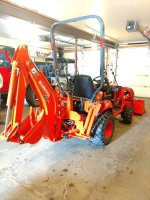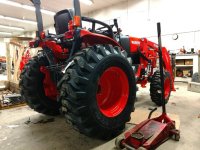WORKING DRAFT (5)
The optimal way to shop for tractors is to list your tasks first, then determine bare tractor weight you need to SAFELY accomplish your tasks. Bare tractor weight is a tractor specification easily found in sales brochures and web sites, readily comparable across tractor brands and tractor models.
For most tractor tasks greater chassis weight is more important than tractor horsepower. This tractor fundamental is difficult for people new to tractors to comprehend. In subcompact and compact tractor categories it requires a 50% increase in bare tractor weight before you notice a significant tractor capability increase. It takes a 100% increase in bare tractor weight to elicit MY-OH-MY!
Heavier tractors are built on larger frames with larger wheels/tires. Heavier tractors with large diameter tires have more tractive power pulling ground contact implements, pushing a loader bucket into dirt and pushing snow. Larger wheels and tires mean more ground clearance, enabling a heavier tractor to bridge holes, ruts and downed tree limbs with less bucking, yielding a less disturbing passage over rough ground.
Safe hillside operation demands more tractor weight than flat land operation and requires four wheel drive (4-WD). Greater mass of heavy-chassis tractors increases tractor stability when transporting loads in the FEL bucket, the most rollover prone of routine tractor tasks. Heavier tractors have adjustable rear wheel spreads; wide rear wheel spreads reduce tractor lateral instability.
Shop your weight range within tractor brands. Budget will eliminate some choices. Collect a dealer brochure for each tractor model in your weight range. I spreadsheet tractor and implement specs, often a revealing exercise. I have a column for cost per pound.
Tractors under 3,000 pounds bare weight are offered in one configuration. Most, such as the high volume kubota standard L series, are sparely equipped to hit competitive price points. Others, such as the Yanmar YT235 and Kubota
B2650/
B3350 series, include enhanced productivity and comfort components.
Most tractors under 3,000 pounds bare weight operate in residential applications on one to five fairly flat acres. These "residential tractors" fit in a typical garage.
Tractors over 3,000 pounds bare weight are generally offered in a utilitarian configuration and a deluxe configuration, on a common chassis. Deluxe kit enhances productivity and operating comfort ~~~ but you have to pay. Many tractors over 3,000 pounds bare weight are too tall to fit in a typical garage, even with ROPS folded.
Selling a used tractor is easy. Selling light implements in order to buy heavier, wider, implements for a heavier tractor you eat more depreciation on the implements than on the tractor. Passing time with multiple implement browsers is a pain. ((Ask me how I know.))
For most new to tractors a quality dealer, reasonably close, available for coaching, is important. Almost every new tractor is delivered with a minor glitch or two that requires correction. My Kubota dealer is six miles away. I feel my local dealer continues to add value to my equipment. Dealer proximity is less important to others, well experienced with tractors, who perform their own maintenance.
BUY ENOUGH TRACTOR.


